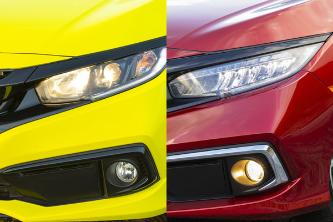led vhdl
Artikel Terkait led vhdl

All-new 2020 Honda City debuts in Singapore: New 1.5L DOHC engine, from SGD 93k
wheels via a CVT-type automatic transmission.Equipment-wise, both variants of the Honda City receive LED
Live Photos: 2020 Honda City Turbo RS at the Bangkok International Motor Show
take a closer look at how much car one gets for THB 739,000.Up front, it gets the new family face with LED
Toyota C-HR Malaysian Configurations, a Sporty and Efficient and SUV from Japan
Unlimited warranty.The C-HRs sporty outlook is complemented by a pair of sleek projector headlights with LED
Halogen vs LED headlights: Which is better?
obtained with the LED light.Q: So, LED lights have fans?
Shopping for a Vios? Honda wants to give you RM5k in rebates for Honda City and BRV
The V variant features New LED Headlights with LED Daytime Running Lights (DRL), New LED Fog Lights,
Spyshot: LED headlights on the new 2021 Proton Iriz and Proton Persona?
seemingly confirms yet another new feature will be introduced on selected variants the duo – LED
Leaked: 2021 Proton Persona MC2 facelift looks much better with LED headlights, new interior
wheels (the current range only gets 15-inch units), and a redesigned front bumper.Theres a set of nice LED
Worth paying RM40k more for a Mercedes-Benz C300 when a C200 is good enough?
here is the headlights on the C200 are normal adaptive LEDs while the C300 uses anti-glare MultiBeam LED
All-new 2020 Hyundai Sonata previewed in Malaysia, first right-hand drive market?
market, HSDM will be offering just one variant of the all-new Sonata, which includes these equipment: LED
New 2020 F48 BMW X1 facelift – What’s new?
the front end of the new BMW X1, the X1 LCI gains a new trapezoid kidney grille, surrounded by new LED
All-new 2021 Nissan X-Trail spyshots - full LED headlights, 1.5-litre hybrid
X-Trail has been spotted testing on the road, revealing a more muscular silhouette and new front and rear LED
All-new BMW 4 Series (G22) - Can it boast just as big as its grille?
All models come with standard LED headlights. Adaptive LED Headlights are available as an option.
All-New Mazda 3 Now In Malaysia, Yours From RM 139,770
SkyActiv-Drive automatic transmission.Standard equipment on the Mazda 3 1.5 Sedan and Hatchback models include: LED
2020 Toyota RAV4 launched in Malaysia, 2.0 and 2.5 Dynamic Force engines, priced from RM 196,436
automatic transmission.Standard equipment on both variants of the 2020 Toyota RAV4 include: Automatic LED
New Toyota Yaris facelift launched in Thailand; ADAS, automatic LED Headlights
connectivity.Cosmetically, the new Toyota Yaris is sharper than the outgoing generation with narrower squinty automatic LED
Another teaser for all-new 2020 Honda City - Features LED taillights
This time it features the LED taillights.Model shown is the Thai-spec City RSJust like its last teaser
Live Photos: New 2020 Toyota Fortuner at the Bangkok International Motor Show
Known as the Standard Model and Legender Model, both variants get LED headlamps with sequential LED signal
Volkswagen offers rebates on the hottest hatchbacks in town
Milton Keynes alloy wheels, 12.3” Active Info Display, 8” Discover Media with App-Connect, LED
All-new 2020 Honda City debuts in Thailand, 1.0 Turbo meets RS
It gets a pair of sharp projector-type headlights and LED daytime running lights.The sides of the all-new
2021 Nissan Navara facelift unveiled - Mother trucker updated with LED headlights, ADAS
facelift is finally unveiled after several teases.As seen in the previous teaser, the headlamps are LED
Review Post led vhdl
"Hello World" a.k.a. LED blink on Logi-Pi, my first ever FPGA programming with VHDL http://t.co/gLylzSkYSX
4-bit signed #binary adder in #VHDL using DE0-CV #FPGA. Far bottom left LED turns on when 2's compliment overflow occurs. The sum can only be from -7 to 8 or else garbage. https://t.co/3GbBW6IonE
Don't miss the Sep/Oct edition of Elektor! Topics: MQTT Sensor Hub; Flicker-free LED Dimmer; DIY Horticulture Box; Time-Corrected Woofer Concept; ADC Using a PLD; Car Battery Wireless Voltmeter; and more! #LoRA #DIYaudio #DIYelectronics #maker #tech #VHDL https://t.co/zwb6YHkskb https://t.co/SRYyZolOZK
Trying to make a simple AND gate in VHDL using Quartus and it's not working :S I'm driving an LED on a breadboard and the gate *seems* to be acting as an OR gate. Any idea? https://t.co/mxHcdXNdsl
A new board just came in right from China. It's time to start playing with #Altera. So 'blinking_led' is like 'hello_world in the #CPLD / #VHDL world :) https://t.co/44CVrYCcUP
LED blink in VHDL on orange crab, check. https://t.co/0Yn5GF8SFt
#PJ5CPU Full test. So now the VHDL/FPGA version of our TTL CPU now runs all the same tests. So now we have a more "portable" version to test add-on hardware, like the RGB LED display. TTL version on YouTube - https://t.co/1Bj26XFeky #GeekChic https://t.co/sQQMNoE2SV
7-segment LED display hardware and VHDL module for MiniZed: https://t.co/Vu39fvFiKs https://t.co/qsp9hKGR7q
Got #FPGA Projects? We do! https://t.co/NDeYplN2LG #Basys #Nexys #Zybo #Genesys2 #debug #HDMI #LED #VHDL #DDR https://t.co/Zy59ldkUiA
Here we go :) compiled and downloaded my first blinky vhdl (the green led..) https://t.co/S0c6gCOHRg
Review Q&A led vhdl
Which do you prefer when programming an FPGA: VHDL or Verilog? Please compare and contrast.
I’m biased. Because I understand and used to teach VHDL coding, I am more comfortable with VHDL. But this is minority stance these days. There is no difference in the capabilities of each language. VHDL is more structured and more picky. It’s harder to do things like signal assignment to dissimilarly-typed signals: Integer, Signed, Unsigned numbers require conversion functions to be inserted, for example. This creates the verbosity that many complain about, but once you code a project or two, you think nothing of it. That said, Verilog is easier to learn, though it is (IMO) less consistent in its syntax. That easier learning curve has led to Verilog (and SystemVerilog) being the language I’d recommend learning, if you’re starting out. Once you learn the quirks of either language, you can implement just as effectively. There are a lot of tribal arguments for and against each language that I don’t buy into. One pet peeve I have is the use of “programming” when designing a digital system, whether it be FPGAs, ASICs or a board. It’s hardware design. I’ve seen a few times when someone approaches FPGA design as a programming task, and come up with a poor implementation because of this mindset. Think of the structures you want to implement, then think of the HDL that you need, to implement those structures. If you think in term of a sequential programming task, you will not get the optimum implementation.
If data taken from sensor is greater than 10 cm, green led is on. If it is smaller than 10 cm, red led is on. How can I write this code using VHDL programming language?
You don’t have quite enough information here to answer the question. You haven’t defined how you communicate with the sensor, how wide the input data is, or what binary value represents the dividing line between 10cm, more than 10cm, or less than 10cm. Also, what if it’s equal to 10cm (if that’s an available expressible value.) At the end of the day this will boil down to a simple assignment of a continuous signal output being 1 when greater than (value) for green, and a separate signal assignment for red being equal to “not green”. However, that still doesn’t answer the question of what if the input is exactly equivalent to 10cm.
Does FPGA get rid of the hardware/software distinction?
Not exactly. An FPGA is still a hardware design, but you’re able to update that design as if it were software, after a compile and layout of your design. So the design process becomes much more like software design in the fact that you can cycle through changes many times per hour or day (depending on the complexity of your design, of course). What you’re designing is still hardware, but some of that’s also become more like software, in that you’re probably designing in a high-level language like Verilog or VHDL, rather than at the gate or transistor level. FPGAs are based on an array of gates, like a gate array, only rather than a metal mask layer, there’s some kind of memory that connects (or disconnects) the various signals. This is usually either flash memory or RAM… obviously, a RAM-based FPGA needs some means of storing its image. This has led to an interesting evolution of FPGAs. Since they’re based on the same large-scale processes as other ICs, they’ve grown cheap and large over time, eliminating the cost-benefit of custom ICs for smaller production, and even serving as a useful tool for prototyping custom chips (gate arrays, full custom ASICs). On my first FPGA project, back in the late 1990s, I was developing a special modem for datacasting over analog TV on a basic ISA-bus card. The card was designed to allow programming of the FPGA, and the FPGA code was integrated into the driver for this modem. So whenever the system booted, that code was loaded. This allowed us to essentially send out bug fixes or improvements for our modem. I have a little computer on my desk called the Vampire 4 Standalone. This is an Amiga-compatible computer. If you don’t recall, the Amiga systems were a series of computers made by Commodore in the 1980s and 1990s, one of the first systems to offer graphics acceleration and multitasking. Anyway, those were based on the Motorola 680x0 processors and three custom chips designed in-house (originally from the Amiga startup company). The Vampire V4 contains an Altera Cyclone V FPGA that implements both the custom Amiga chips and a 680x0 core, the Apollo 68080. This is by far the most modern, most sophisticated 680x0 implementation ever designed: superscalar, out-of-order CPU and FPU execution, vector instructions, fully pipelined, etc. And improvements to CPU, graphics chips, etc. can simply be downloaded into the FPGA. So this isn’t just Amiga-compatible, it’s the fastest 680x0 Amiga ever. And it’s independent of 30-year-old technology! And oh-by-the-way, if for some unfathomable reason one wanted to, this could become the fastest Atari ST known to mankind instead of being an Amiga! Read More APOLLO 68080 - High Performance Processor
What should be the approach of an ECE student from first year itself?
Electronics and Communication engineering has scope in following areas: 1.VLSI : This is our core subject. It has two parts : Front end : Design work is done on CAD tools , basically you do coding using hardware description languages like VHDL ,Verilog Back end: It includes manufacturing , here we finally get an IC chip. 2.Embedded Systems: This field is all about how you play with microcontroller chips and your command in making circuits to achieve the desired task. For ex: Street light Controller , Automatic fire extinguisher etc. 3.Internet of Things: I think embedded systems and internet of things are quite related , only difference here is that you have a internet connection! 4. Instrumentation : Although this is primarily a subject of instrumentation engineers we can migrate into it with our experience and knowledge. 5.Software jobs: Some take CS subjects in M.tech specialization and migrate to Software sector 6.Govt sector has a good scope : ISRO , DRDO and BARC are primarily research based govt. organization which have a lot of ECE intake . PSU’s like NTPC, ONGC, BHEL ,etc. also have some seats for ECE. Now, coming to your question: In 1st year you should learn more about embedded systems , for that start working with arduino . Start with basic LED blinking exercises .follow the examples given , they are a great way to learn! Then you go experiment with LDR , Keyboard , LCD display , heat sensors etc. Work modules like RF module , GPS Module and GSM module (SIM900) . This will give you enough confidence to make your own circuits! after this participate in Fests organized by IITS , NITS etc. There you will get a chance to see where do you actually stand! You can learn VHDL language in First Year( for people who would say that i am putting too much for you , i have a junior who has done it all in first year! ) In second year , try to get knowledge of your branch by focusing on academic studies. In parallel contact with BARC , ISRO or DRDO .If you have some contacts or source then you can ask them to get summer training in these institutes. believe me it will add a lot to your profile! If your college has a SAE club , try to get into it ! Also participate in events organised by SAE‘( I participated in ECO-KART competition ) This will improve your overall profile! In 3rd Year Start making a list of electronics companies you want to intern with like TI , Honeywell ,Intel etc. Your contacts in these companies will matter the most ( my friend got summer internship in one of these using the contacts of one of our alumni! he is even getting a PPO ) . Also start preparing for GRE from this point! If you want to know about GRE google it ! In short this is a exam for getting admission in foreign universities. Indulge yourself in social work . Try getting in a NGO ! You can try MAD ! its a big organisation for social benefit. In your final year give GRE! I Hope this answers your query!
How do I design a model in digital design which maintains the count of people present in a room and displays on seven segment LED display?
It is very simple since your specification is very clear. There should be a counter which counts up the number of students coming in based on the switch and the counter is also decreased by another switch which is to count down the people present in the room. To display on LED-7-segment, you need a circuit to convert from binary to hex also. May I know you are going to design the circuit using Verilog/ VHDL or logic design circuit tool?
Can I do something with an FPGA other than make LEDs blink and alter 7 segment displays?
A game with LEDs: For example. don’t fall off the cliff. The LEDs keep running towards the edge(outer LEDs), use switches to play the game. If the LED is running out of the cliff(chain of LEDs), game over. Otherwise, use switches to control the direction of the LEDs running. Increase/ Decrease the speed of running to change the difficulty of the game. Many more FPGA/Verilog/VHDL projects as follows: FPGA Projects, Verilog Projects, VHDL Projects - FPGA4student.com FPGA Projects Verilog Projects VHDL Projects
Is it feasible to learn VHDL or Verilog without having access to an FPGA?
Actually, testing on an actual FPGA is probably the least important part of learning VHDL or Verilog (also as a suggestion, I believe VHDL and SystemVerilog are much better languages than Verilog). There are only four things that really matter when you are first starting out: Is your code synthesizable? Synthesizable means that your code can actually be compiled into hardware (gates and flipflops). This is perhaps the thing beginners struggle with most: figuring out how to write code that is synthesizable. Most people try to write Verilog and VHDL the same way they write software languages like C or Python. The problem is, unlike software languages where the entire language is compilable in all situations, HDLs like Verilog and VHDL only have a subset of the language that is synthesizable (the rest is used for simulation and testing only). A good example of this is while loops (loop like functionality is often implemented as state machines). A good rule of thumb is that you should be picturing (or better yet drawing) roughly the hardware you want and translating that to code. Mastering the difference between synthesizable and non-synthesizable code is the most important part of learning these languages, and they only thing you need is a synthesis tool (Altera and Xilinx both provide free versions of their tools online). Does your code fit on your FPGA? If it doesn't, it'll never work. The other pit fall many beginners fall into is writing code that is technically synthesizable, but ends up being much more hardware logic than they anticipated. This in turn results in designs so large they are not practical. A good example is division: division is a very expensive cooperation in hardware, and can often take more than 1/4 of the FPGA. Another would be for loops with a loop dependency (dependencies between loop iterations) as this often becomes a long chain of cascaded logic (in general, avoid loops when you start out: anything that requires iteration should be implemented as a state machine). Once again, all you need to test this is to compile your code on Altera's or Xilinx's synthesis tools. As a rule of thumb, any code your write in the beginning should not take up more than 5% of the FPGAs resources (LUTs or registers/flipflops). Can your code run at a reasonable clock frequency? The last pitfall beginners fall into is forgetting that there is a maximum clock speed (fmax) their design can run at. This clock speed is very dependent on how your code is written (tl;dr the more logic on the path between two flipflops, the slower your clock speed will be). A few good examples of things that could result in a very low fmax are division and loops with loop dependencies. Don't worry too much about it initially, as long as your fmax is in the MHz. Once again all you need to do to check this is to compile your code in the FPGA tool of your choice. Is your code functionality correct? Given that your code is synthesizable, the only other thing that determines if your code would work properly on an FPGA is if it is functionally correct. The best way to do this is to write a testbench (hardware speak for test code) that tests your design, and run it in a simulator (such as ModelSim which comes bundled with Altera's tools). If your design works as expected when tested with your testbench in simulation, then your design would work on an FPGA! Take note that your testbench does not need to be synthesizable (it really only exists to test your design in simulation, so this is a good opportunity to use the non-synthesizable parts of the language to make your life easier). Until you are comfortable with writing synthesizable code, I suggest planning out your design (drawing a rough diagram of your hardware before you write any code when you’re starting out is a good exercise), writing your code, synthesizing, then checking it is functionally correct in a simulator with a testbench. Unfortunately you never get the satisfaction of seeing it actually run on a FPGA, but in all honesty, this is how I learned, and I loved it. Besides, real world working hardware isn’t that exciting (blinking LEDs never excited me, but I seem to be in the minority).
What are some recommendations for a good FPGA development kit?
A specific devkit recommendation: the Terasic Cyclone V Starter Kit. It is built around an Altera Cyclone V device, big enough for significant projects. Around $180 US Has plenty of built-in peripherals including slide switches, push button switches, discrete and 4-digit 7-segment LEDs, Static and dynamic memory, flash configuration memory, audio, video, USB, HDMI, ADC. You can add-on Arduino hardware, using the Arduino header. There are plenty of General Purpose I/O pins bonded out and made available in a 40-pin header. I’m afraid I only know of Altera devices so I can’t comment on Xilinx based offerings, but this board is a great low priced entry point, and will allow for a lot of projects because of its generous I/O. As another writer has noted, FPGA devices have evolved into SoCs. There are a lot of built-in “Hard” structures (these are diffused directly into the silicon, not built up from programmable logic elements) so it’s important to learn how to use these elements as they are used as a matter of course in the real world: External memory interfaces, high-speed transceivers, internal embedded memories, arithmetic blocks for implementing DSP. Which language? Verilog. I say this reluctantly because I am a VHDL person. But realistically, Verilog. You'll be able to understand either, eventually. More important to understand: event-based simulation cycle. Understanding event-based simulation will help you understand *why* a synthesis tool implements your code the way it does. The event-driven simulation cycle is the same whether you choose Verilog or VHDL so understanding this will let you avoid common mistakes which plague beginners to either language. How much can be learned via simulation? Pretty much everything. In that sense you do not even need a devkit. But watching waveforms is not as much fun as making the blinky lights blink!
Which is the best specialization with respect to future scope in electronics industry?
Trend is embedded is growing well many companies in India producing good embedded devices and offering many jobs. ,Vlsi, Currently some what limited as compared to other, reason is it require deeper knowledge and skilled employee then any other fields and it requires high cost specalizd ,EDA , tools.since fabrication and prototyping is expensive no semi coductor manufacturing company in India (foundary). India we are doing only testing and verification jobs according to VLSI field.job oppurtunites expected to grow in VLSI ,Skills required to get into VLSI, Strong in digital electronic Strong knowledge in both verilog and vhdl For verification strong in system verilog and verification methodology Scripting in perl Mostly they recruit ,mtech For ,btech ,its easy to get into FPGA based embedded bsystem companies than asic-vhdl/verilog hdl based companies Now led industry offering many core jobs., Do you need anymore clarification
How do you write I love you in a programming language?
In ,R lovestring <- "I love you!" print ( lovestring) You get: "I love you!" I thought I would do one that nobody else has done, so here’s ,VHDL library ieee; use ieee.std_logic_1164.all; use ieee.numeric_std.all; entity ilove_you is port ( clk : in std_logic; led : out std_logic ); end ilove_you; architecture rtl of ilove_you is constant CLK_FREQ : integer := 20000000; constant BLINK_FREQ : integer := 1; constant CNT_MAX : integer := CLK_FREQ/BLINK_FREQ/2-1; signal cnt : unsigned(24 downto 0); signal blink : std_logic; begin process(clk) begin if rising_edge(clk) then if cnt=CNT_MAX then cnt <= (others => '0'); blink <= not blink; else cnt <= cnt + 1; end if; end if; end process; led <= blink; end rtl; In ,x86 assembly language, for ,64-bit Linux: ,(nothing else will work). global _start section .text _start: mov rax, 1 mov rdi, 1 mov rsi, message mov rdx, 13 syscall mov rax, 60 xor, rdi, rdi syscall section .data message: db "I love you", 10 (There may be some errors for the assembly example, if anyone knows x86 feel free to suggest edits). Haskell,: #!/usr/bin/env stack -- stack --install-ghc runghc main :: IO () main = putStrLn "I love you!" Vimscript,: :echom "I love you" That’s “I love you” in programming languages not mentioned yet!
 Beranda
Beranda 


